LOSING MY HEART ON THE LLŶN PENINSULA
 Lush woodland path, Plas-yn-Rhiw estate
Lush woodland path, Plas-yn-Rhiw estate
It has already been a frantic summer with non-stop gatherings and celebratory toasts. It is the end of school for our youngest son (and the end of an era for us), our twins have turned 21 and there has been the happiest Gloucestershire wedding – my sister to the learned doctor – who took time out from his gruelling hospital shifts to bake these tiny wedding cakes:

Tiny wedding cakes from my sister’s wedding to the learned doctor
Not surprisingly I am in a somewhat fragile state by the time I find myself on a radiant July evening sitting on a remote grassy slope at the end of the Llŷn Peninsula – known by some as Snowdon’s Arm – in North West Wales. Accompanied as I am by marvellous and ever patient husband, Nick, I am ready for a little romance myself.

Just stopping for a while to take in the quiet and the view of Porth Neigwl (Hell’s Mouth), Llŷn Peninsula
The garden we have come to see, Plas-yn-Rhiw, has closed for the day moments before we arrive. But although this is frustrating, there is something very sweet – when you are very tired – about converting to a simpler agenda, just raising your face to the evening sunshine and taking in the blue curve of the bay below.
The next morning is heavy with an almost tropical grey sky:
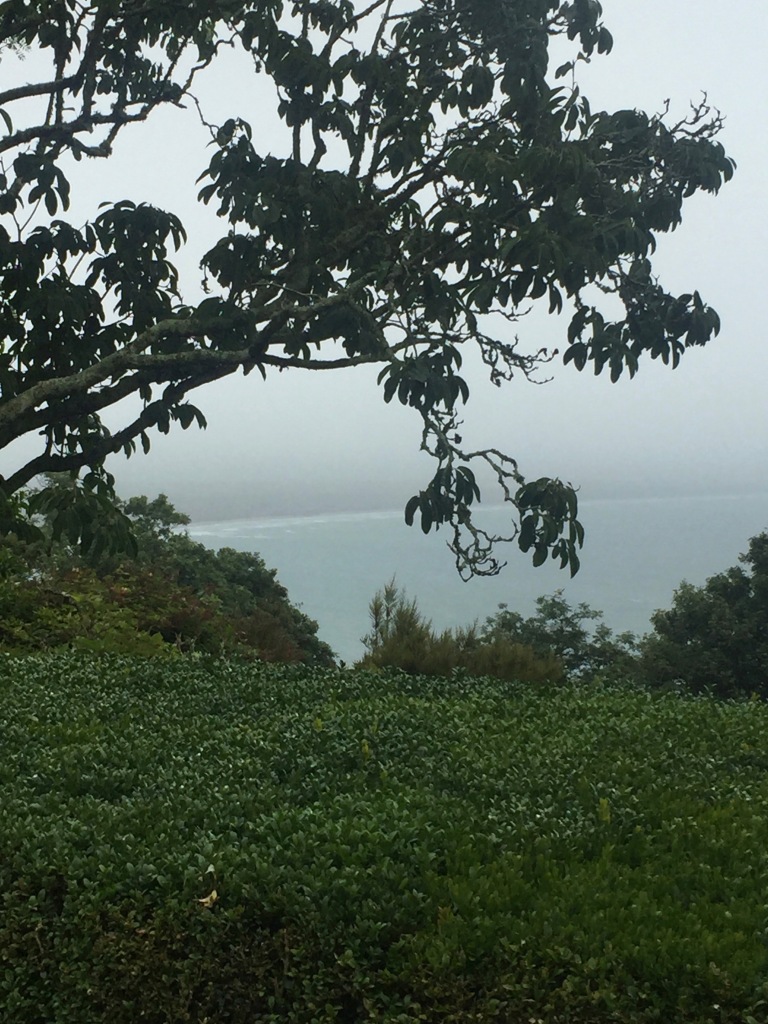 Almost tropical grey sky with view across Hell’s Mouth
Almost tropical grey sky with view across Hell’s Mouth
But I am excited by the lushness of the ferns in the surrounding woodland – I have never seen hart’s tongue fern ( Asplenium scolopendrium) with such long, exuberant fingers – and, by the house entrance, the crocosmia glows neon orange in the eleven o’clock gloom.

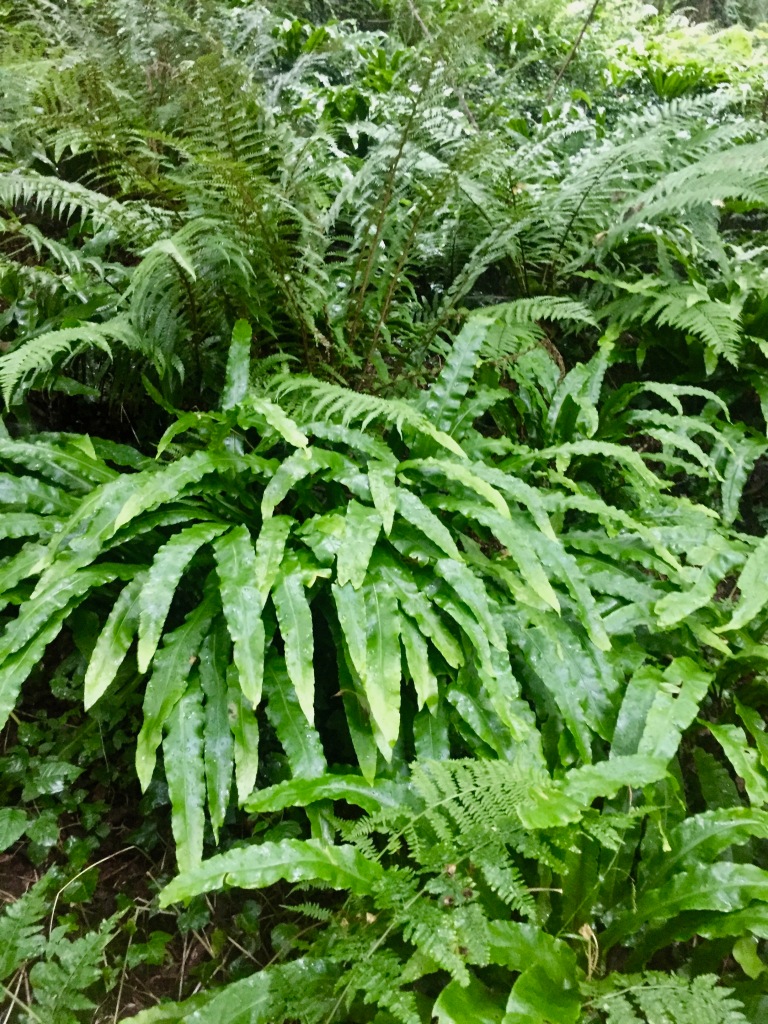 Lush ferns – extra-exuberant hart’s tongue ferns below
Lush ferns – extra-exuberant hart’s tongue ferns below
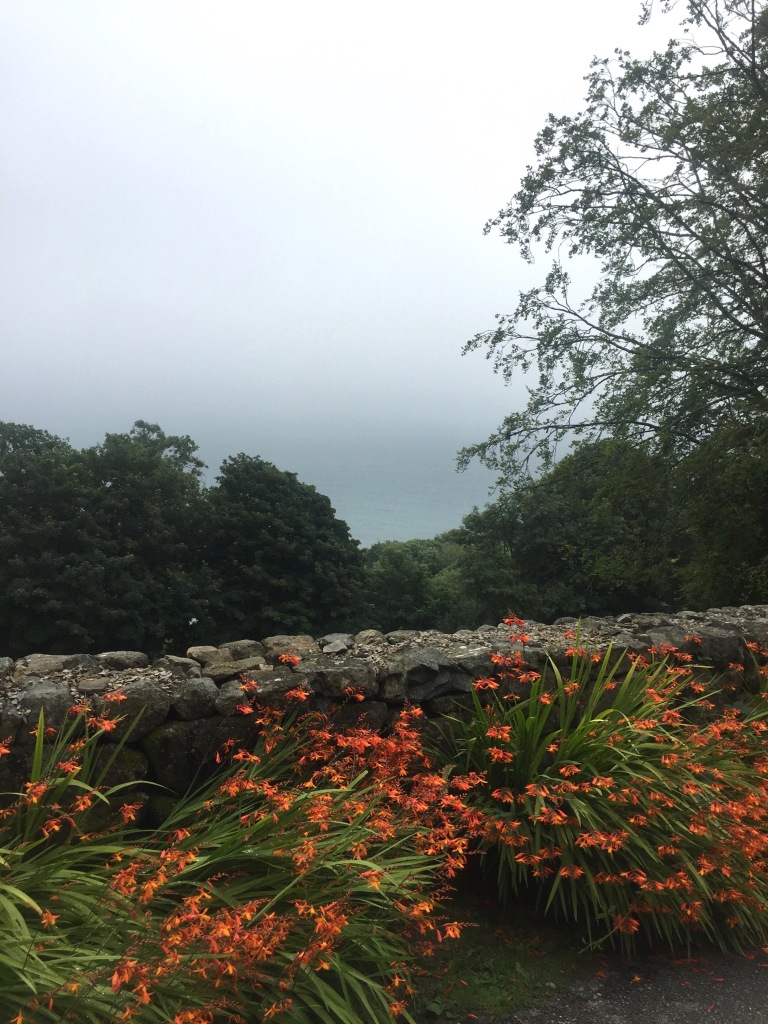 Crocosmia glow neon-orange in the morning gloom
Crocosmia glow neon-orange in the morning gloom
Plas-yn-Rhiw is a small 17th Century stone manor house built onto a hillside ledge with wonderful views of the sea, entirely surrounded and protected by woodland. In 1816 the house was extended and elegantly glamorised. The roof was raised to add an extra floor, french windows leading onto the garden were cut into the sturdy walls and a slim-limbed Regency veranda was constructed along the facade. But having remained in one family for nearly three hundred years, the house was sold in 1874 and then abandoned in 1922 by the son who inherited it and left to decay.
The rarity of the house and the exquisite nature of its position was noted by the architect Clough Williams-Ellis who designed the Italianate coastal village of Portmerion (about 50 miles away) and whose own imaginative and stylish garden at nearby Plas Brondanw is absolutely worth visiting.
Williams-Ellis had tried to get a friend to buy it in the early twenties and wrote passionately about the property as an important example of Welsh rural architecture that needed saving. “To those sailing bleakly across Hell’s Mouth bound may be for the last hospitality of Aberdaron or northwards around North Wales’ land’s end through Bardsey Sound – there is just one spot where the eye may gratefully rest on relative ‘snugness’ and that is where the wooded policies of Plas-yn-Rhiw meet the sea in a little bay. Here, sheltered by the shoulder of its protecting mountain from the tempestuous west, crouches an ancient manor house …its French windows and verandah look out across the wide expanse of Cardigan Bay between its trees and over fuchsias, figs, rhododendrons and azaleas that here flourish so famously that, when I first reconnoitred the (abandoned) place some twenty years ago… the house was buried in a blossoming jungle which also obscured all view of the sea as well as most of the sunlight”.
But, it was in the end three unmarried sisters, Eileen, Lorna and Honora Keating, who, having holidayed on the Llŷn Peninsula since 1919, managed to buy the house and a reduced estate of 58 acres in 1939.
 Eileen, Lorna and Honora Keating with thanks to the National Trust Plas-Yn-Rhiw website
Eileen, Lorna and Honora Keating with thanks to the National Trust Plas-Yn-Rhiw website
There are stories of the garden being so overgrown that the women had to clamber in through a first floor window to view the house. Once it was theirs, the sisters set about restoring the building (a slow process during wartime especially), creating a wonderfully deft and welcoming garden and caring for the surrounding land.

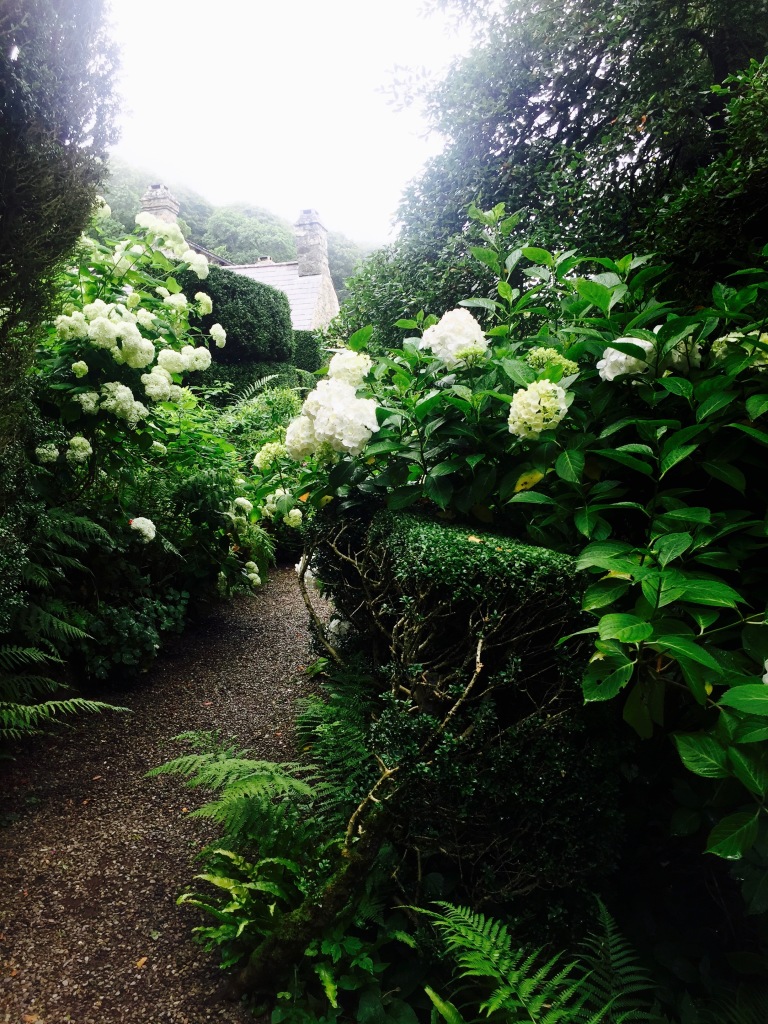 The green and welcoming garden at Plas-yn-Rhiw
The green and welcoming garden at Plas-yn-Rhiw
As time went by they bought up every available parcel until they had restored the estate to about 400 acres so that it could be protected from development and conserved for wildlife. They donated the land to the National Trust in 1946 and donated the house itself in 1952. The youngest sister, Lorna, lived in the house until she died in 1981, but the sisters had opened the house to the public long before. During the restoration process they were keen to unveil the original stonework and the house is filled with (covetable!) old Welsh oak furniture. It looks as if the sisters have just popped out – there is a fur jacket hanging behind a door, a bottle of lavender scent on the dressing table and a small but serious office where business was clearly attended to with wisdom and thoroughness.
Best of all there are brilliant views – and indeed doors – out of the rooms to the garden. Seeing the garden through the French windows of the main living rooms feels comfortable and completely modern, but every glimpse is tantalising, not least from this small kitchen window out to the ruined and romantically planted outbuildings:
 View to ruined outbuildings, Plas-yn-Rhiw
View to ruined outbuildings, Plas-yn-Rhiw
The Keating sisters restored some of the early 19th century outbuildings – there had been stables, a dairy, a threshing shed, coach house and a stone dog kennel – but also, with almost visionary grace, they left many of the buildings as ruins, there to enjoy for the contrast of stone form against living green. There are archways and rough hewn walls brilliantly energised with voluptuous green ferns and the tiny creeping soleirolia soleirolii (the super invasive ‘baby’s tears’) becomes a delicious verdant foil for the handsome cobbles of the courtyard floor.

 The handsome cobbled courtyard and ruined outbuildings energised with green
The handsome cobbled courtyard and ruined outbuildings energised with green
 Soleirolia soleirolii weaving its way between rhythmical courtyard cobbles
Soleirolia soleirolii weaving its way between rhythmical courtyard cobbles
As always in this kind of mild, watery, West coast terrain, I love the way that green starfishes of Maidenhair spleenwort (Asplenium trichomanes) dart across the walls.
 Maidenhair spleenwort – Asplenium trichomanes growing happily on the stone walls
Maidenhair spleenwort – Asplenium trichomanes growing happily on the stone walls
There is running water mirrored by prostrate rosemary flowing almost endlessly to the ground.
 Prostrate rosemary flowing down the wall like water, Plas-yn-Rhiw
Prostrate rosemary flowing down the wall like water, Plas-yn-Rhiw
And there are magical views through glassless window openings:
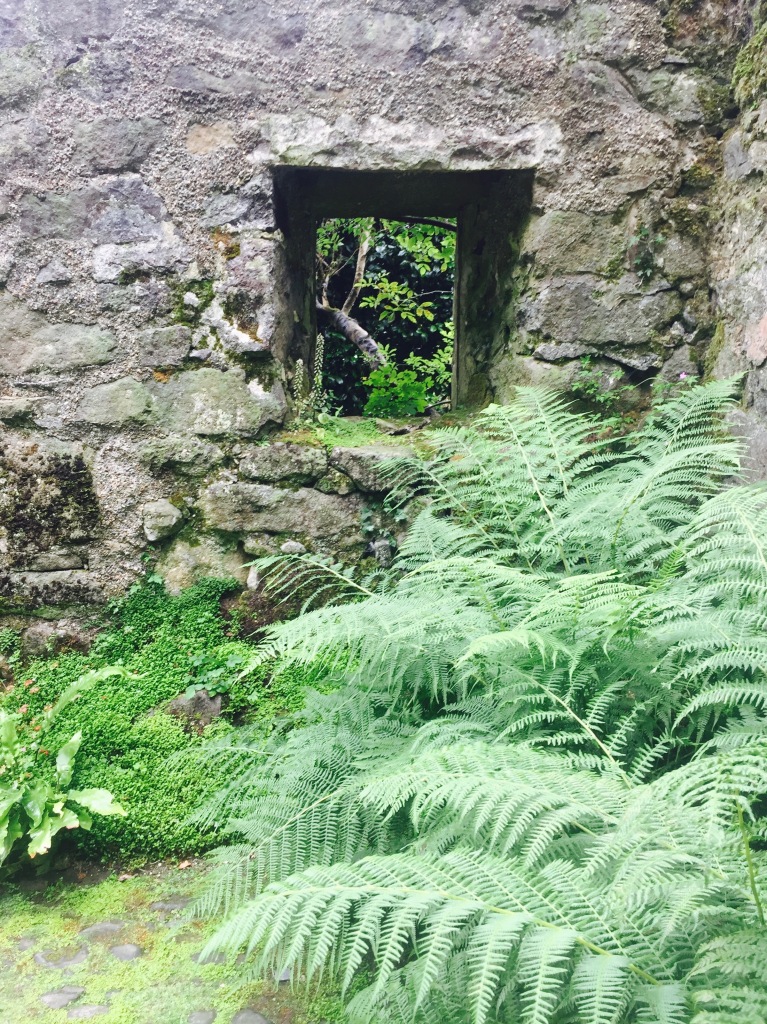
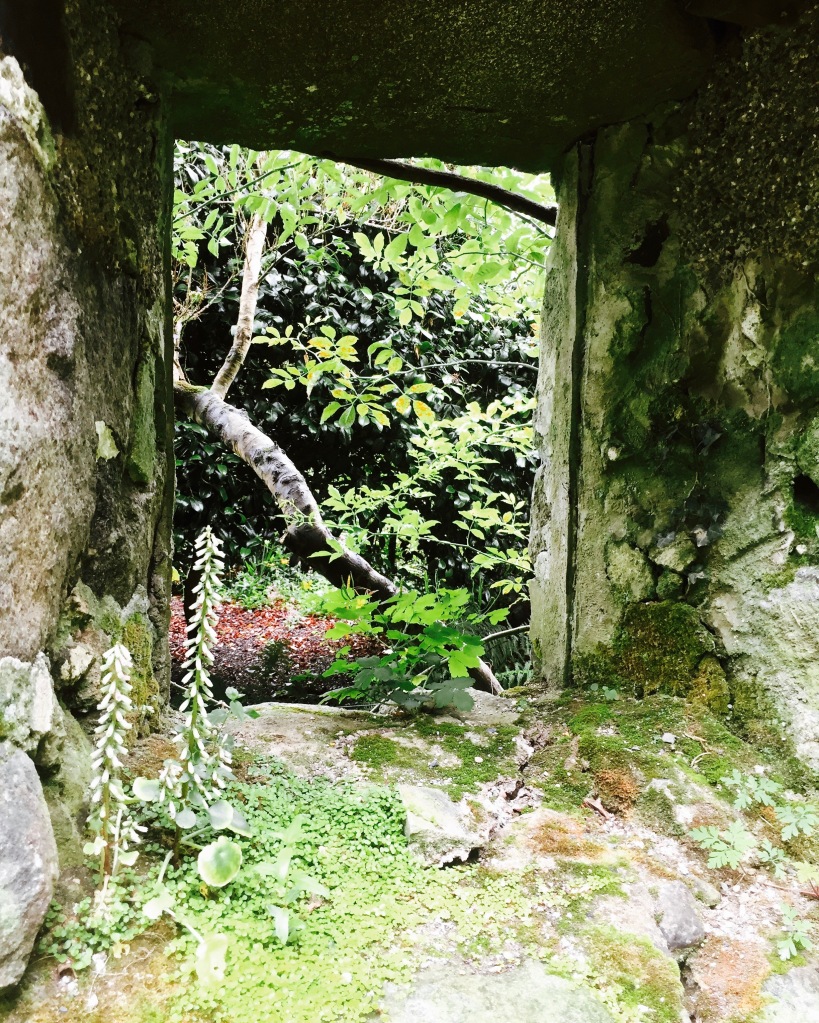 Here the upright forms of Pennywort stand like candles in the window, Plas-yn-Rhiw
Here the upright forms of Pennywort stand like candles in the window, Plas-yn-Rhiw
There is so much luxuriant green. The ferns that line the walls of The Gardener’s Cottage (which is in the middle of the garden – you can rent it for a holiday from the National Trust see the Plas-yn-Rhiw website) are as big as a medium-sized shrub.
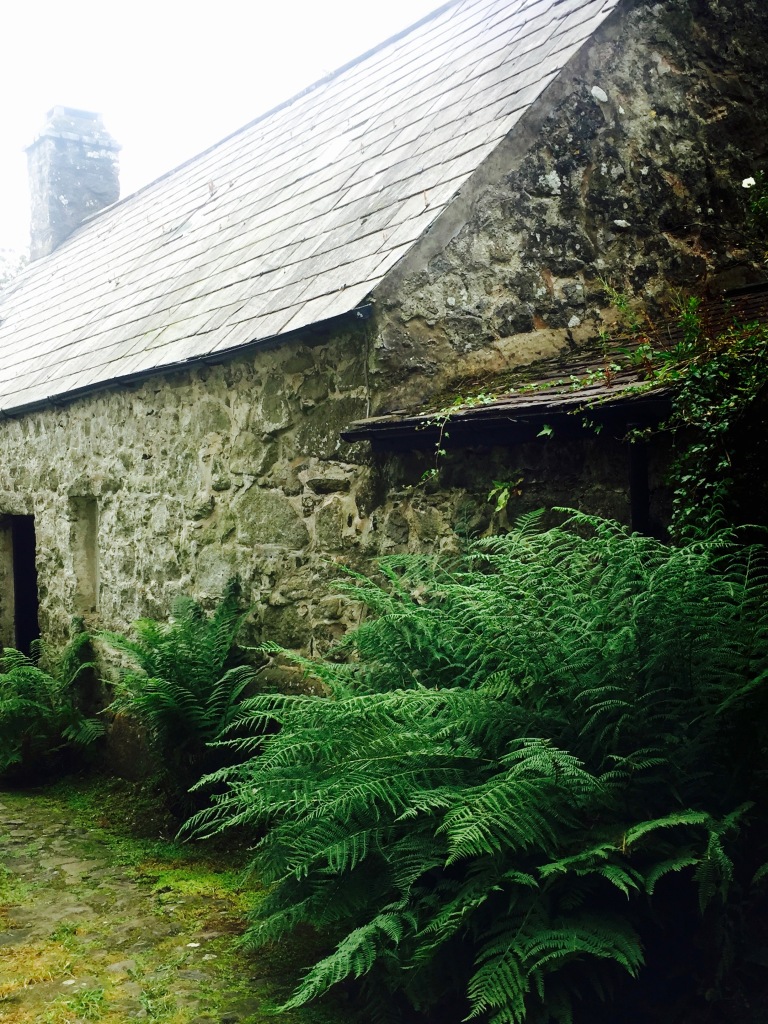 The ferns that line the wall of The Gardener’s Cottage are shrub size
The ferns that line the wall of The Gardener’s Cottage are shrub size
Gentle corridors of dynamic ferns make way for healthy, bulging corridors of deep green box:

 Ferns and box line the paths at Plas-yn-Rhiw
Ferns and box line the paths at Plas-yn-Rhiw
A home-made, age-old sort of layering makes walking through the garden a deeply charming experience:
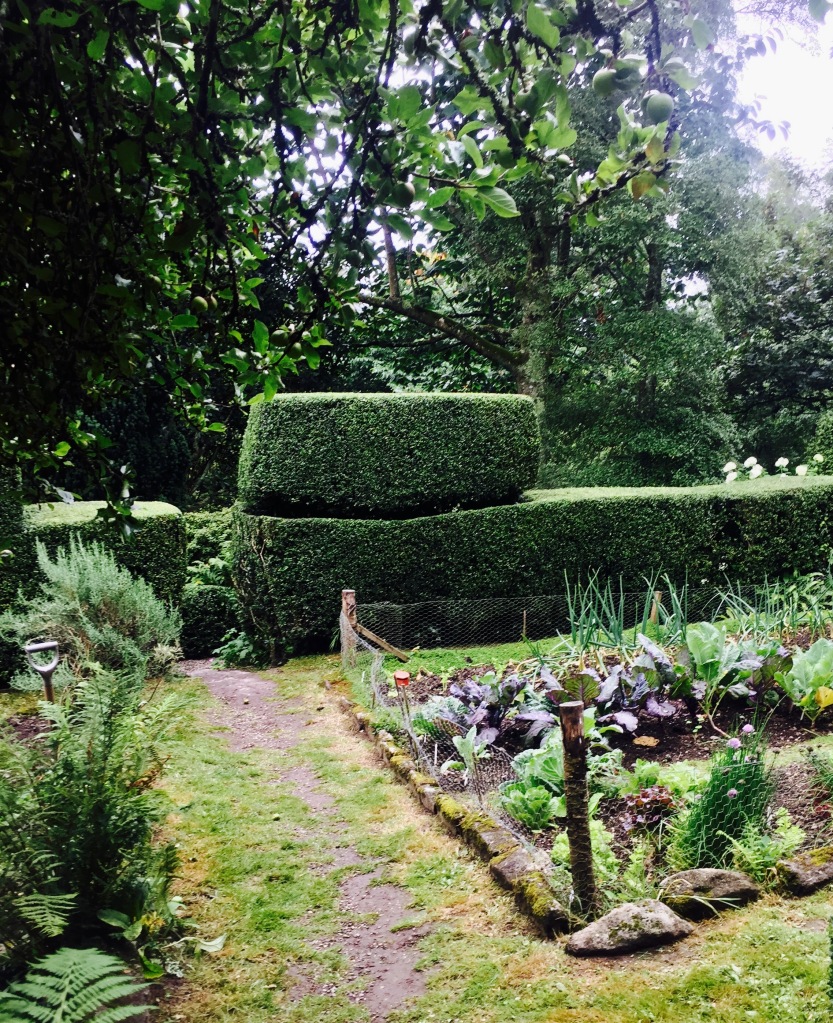
Bulging, layered box hedging surrounds the Kitchen Garden
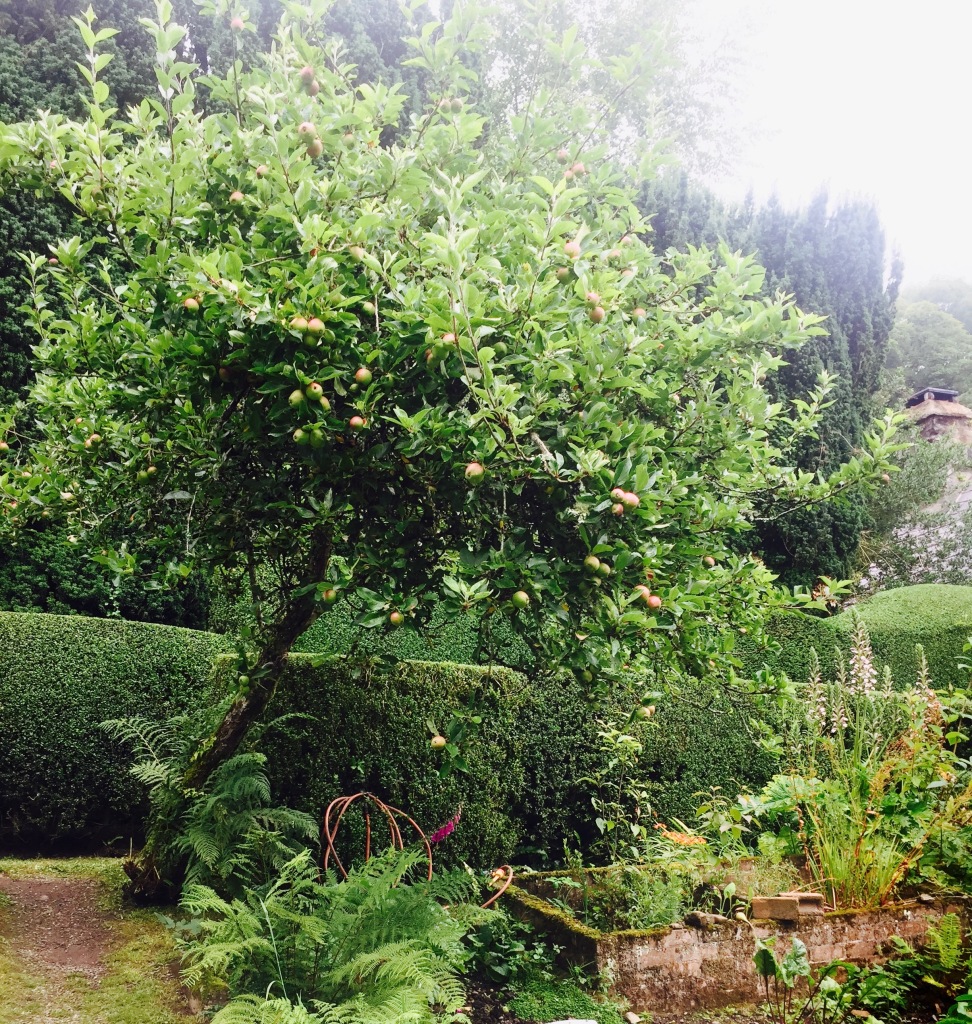 An apple tree leans into position against cushioning box hedges
An apple tree leans into position against cushioning box hedges
The occasional steely mauve of acanthus, pale pink hydrangea and velvety blue of aconitum sing out against the contented sea of green:


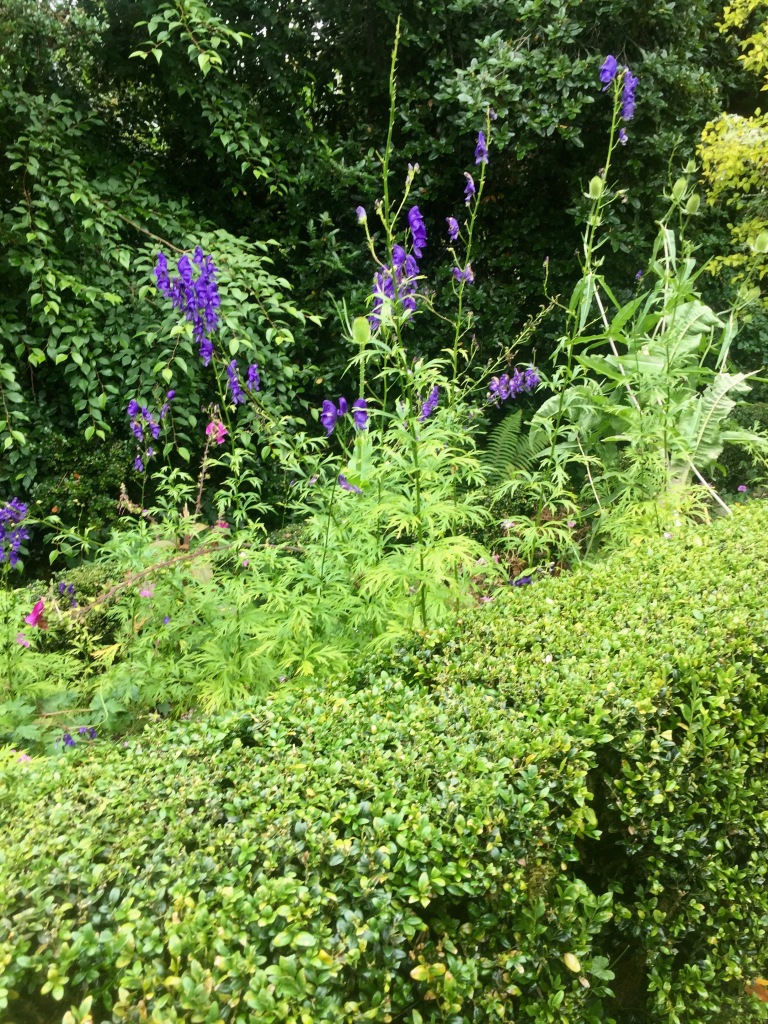 Every so often steely mauve acanthus, pale pink hydrangea and rich blue aconitum sing out against the waves of green.
Every so often steely mauve acanthus, pale pink hydrangea and rich blue aconitum sing out against the waves of green.
At the top of a box-lined path, a former outbuilding has become an inviting chalky white place to sit:
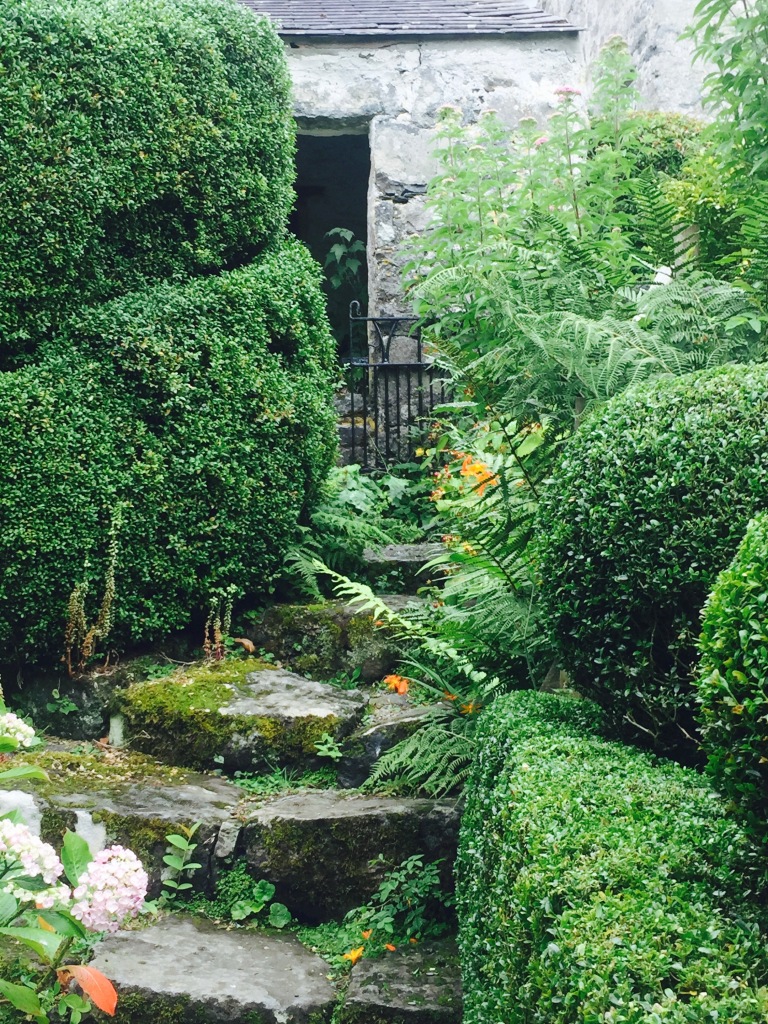
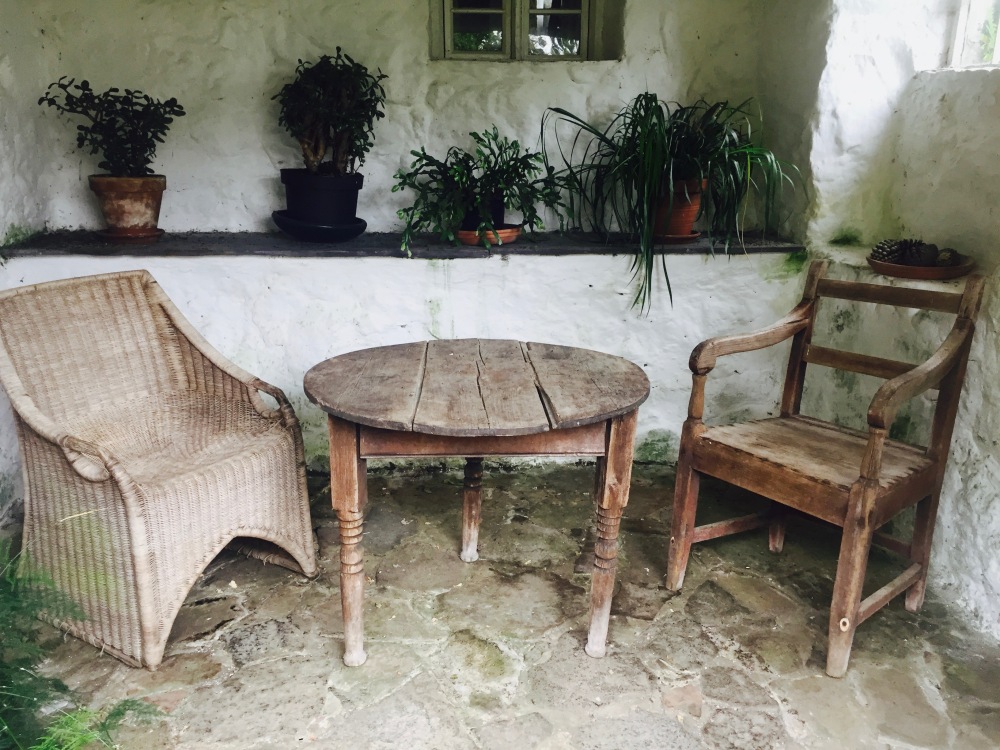
 An inviting loggia has been created from an empty outbuilding
An inviting loggia has been created from an empty outbuilding
At the front of the garden, cheerily uneven compartments of box hold fiery red crocosmia, steely acanthus and royal blue agapanthus against the milky grey sky and matching sea.
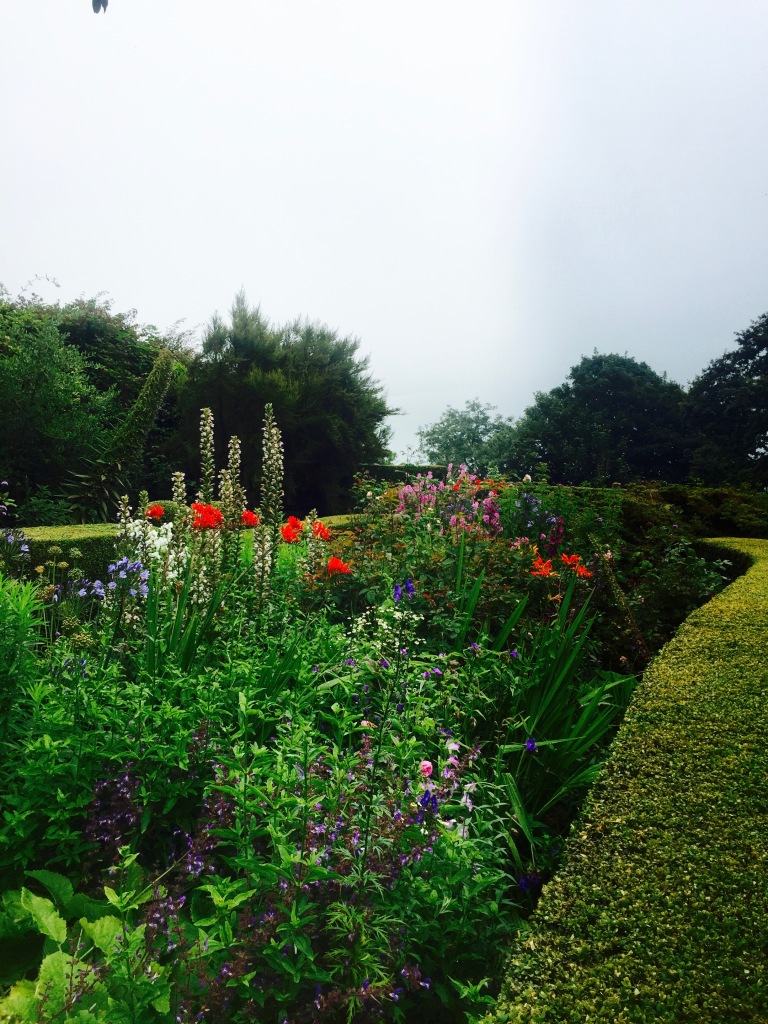

 Cheerily uneven compartments of box hold acanthus, crocosmia and agapanthus against the milky sky and matching sea
Cheerily uneven compartments of box hold acanthus, crocosmia and agapanthus against the milky sky and matching sea
Finally, round to the elegantly groomed front of the house with its veranda and scalloped beds filled with delicate heads of nicotiana and fuchsia:
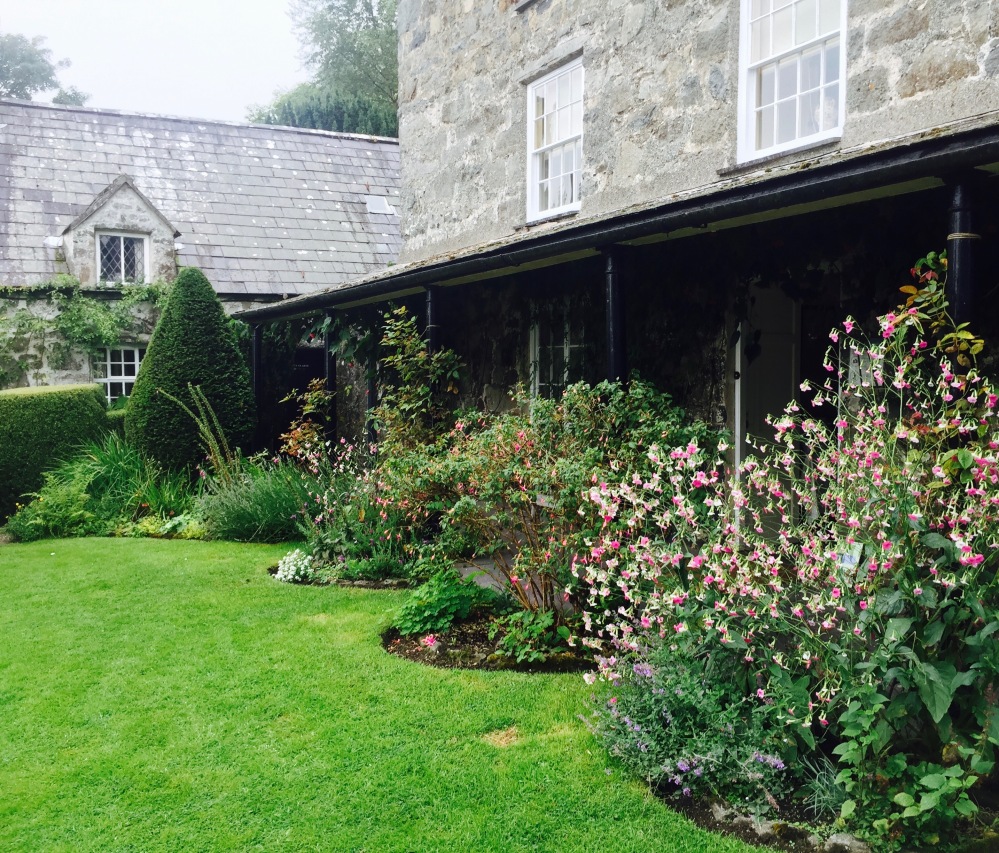 The front of the house with Regency veranda. The Gardener’s Cottage is at right-angles
The front of the house with Regency veranda. The Gardener’s Cottage is at right-angles
In a corner a Hydrangea aspera in bud falls elegantly over a stone trough. The acanthus to its left and purple sage at its feet share the same silvery-purple tones. You get a glimpse here too of the towering trees that rise above the lower level planting. I failed to photograph these but there are gorgeous, lushly growing specimens of magnolia and bay amongst other often slightly unlikely species, many donated to the Keating sisters from other National Trust gardens at their request when they were first renovating the garden and needed anything they could get hold of to fill the space.
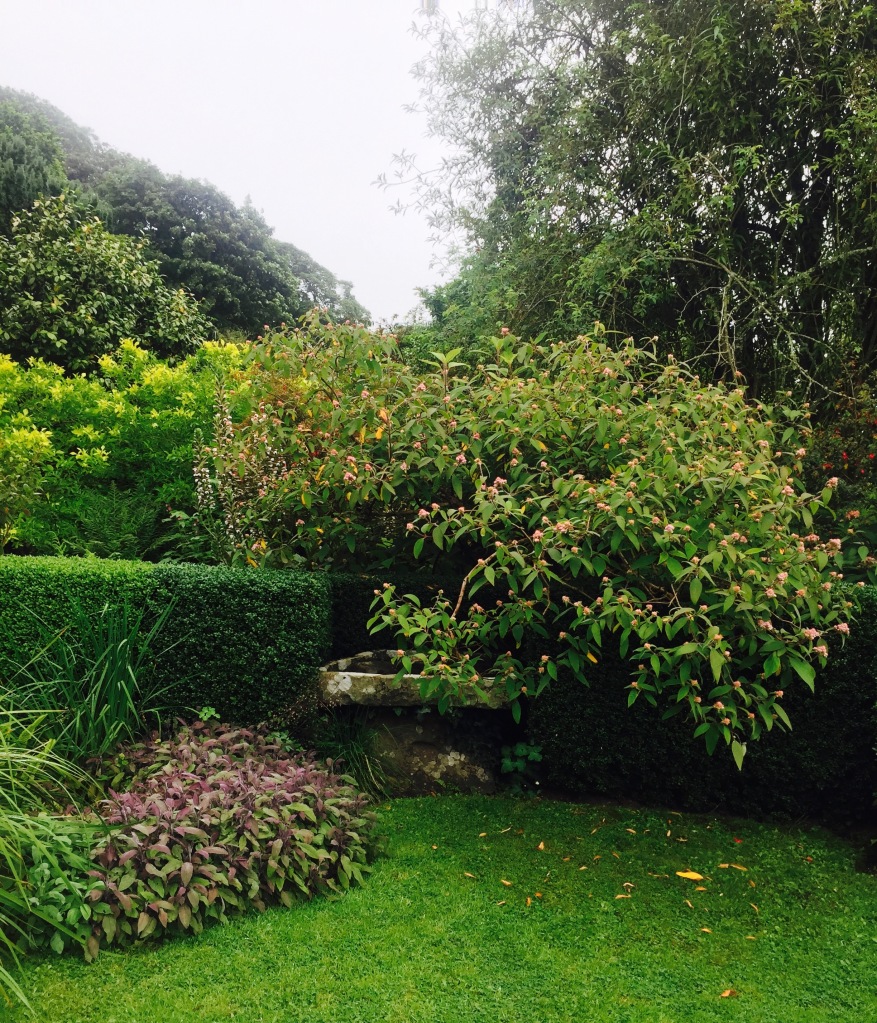 Hydrangea aspera falls elegantly over a stone trough. Acanthus mollis and Salvia officinalis ‘Purpurascens’ are excellent companions
Hydrangea aspera falls elegantly over a stone trough. Acanthus mollis and Salvia officinalis ‘Purpurascens’ are excellent companions
I am completely smitten by both house and garden at Plas-yn-Rhiw. The chance to sit on an old stone bench and relish the green and the spreading view and the occasional electric dash of orange or palest pink. I love the plump, guiding corridors of box and – everywhere – the energy of the ferns.
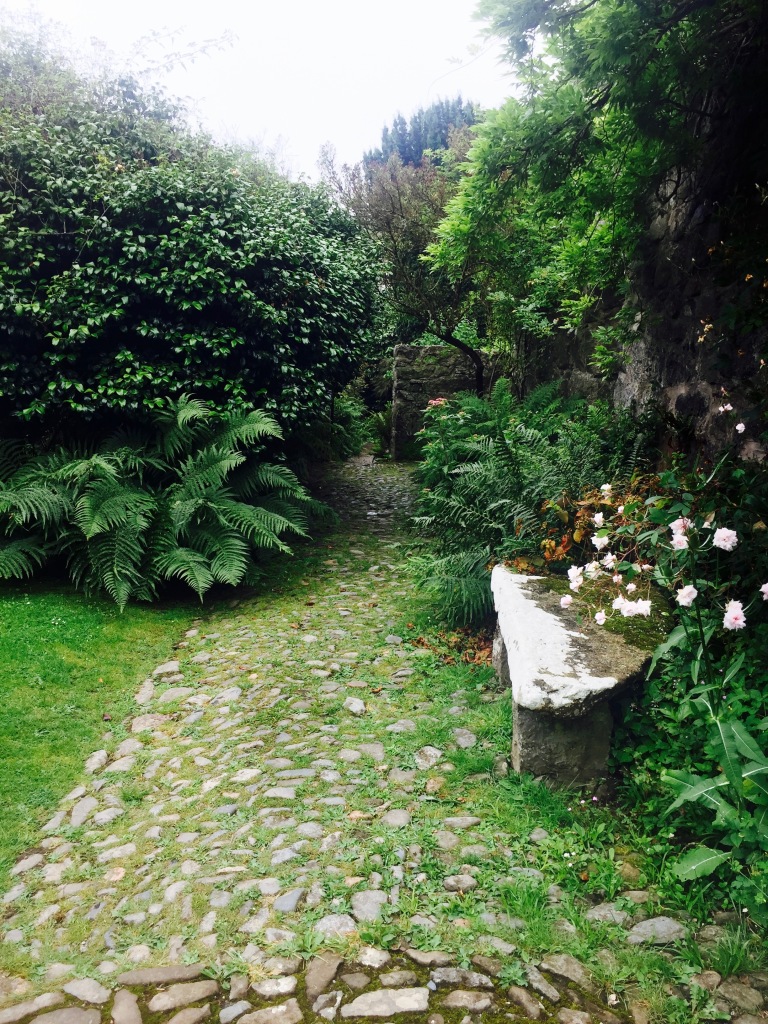 An old stone bench, Plas-yn-Rhiw
An old stone bench, Plas-yn-Rhiw
Throughout the garden old stone walls are an enticingly rough contrast to jewel coloured fuchsias, bright orange crocosmia and, under the elegant Regency veranda, this deep raspberry abutilon which twines its way along the front of the house. A hard place to leave.

Abutilon against the stone facade of Plas-yn-Rhiw

A gorgeous dream of a garden. Thank you for the beautiful photos. I like the jade plant captioned an inviting loggia. I would love to visit.
Definitely visit! The loggia is so simple but the perfect place to sit within the garden – the planting the close up is just the money plant – Crassula ovata convulata, easy to find and so neat and handsome. THANK YOU! All the best Non.
Thank you for transporting us to this lush, verdant and wildly atmospheric garden X
You would absolutely love it! Definitely felt dangerously at home there. Thank you, Deborah! xx
I did visit 3 years ago under a scorching sun, you beautifully captured the magic of the place, I remember have envied the sisters living there, such a wonderful retreat. Thank you for making me revisiting this glorious and bewitching place!
Dear Lucie I am glad that you also found it such an inspiring and atmospheric garden. Thanks so much for getting in touch – incredibly good to hear from you. All the best Non
I stumbled upon a retweet by @midsizegarden and am so glad that I did. A fascinating article with super photos. May I ask what camera/lens you use? I live in Suffolk and will definitely visit this lovely garden thanks to your piece.
So glad you have found The Dahlia Papers. Thanks so much for your kind comments. I use both a Canon EOS camera and my iPhone – they work well for different things. Definitely visit Plas Y n Rhiw!
Vivid and wonderful appreciation of dingy summer holiday weather, Non. Thank you!
Thanks Charlotte! A garden you would love, I am sure.
Some really beautiful views here!
A gorgeous and uplifting place
I’ve just shown my hubby and we’re planning a trip 🙂
Thanks Non. You have a knack for hitting the right note. Enjoyed this travelogue to the point of booking a stay.
What a stunning piece of the world, this is definitely a place to visit on my bucket list. Looks so serine and tranquil i wish I could live there 🙂
Pingback: 8 gorgeous garden visiting blogs | Blog at Thompson & Morgan